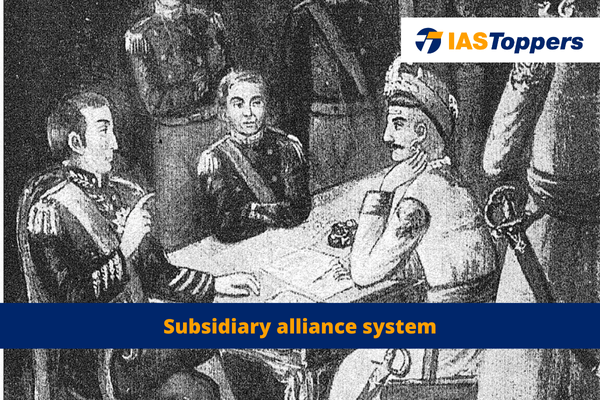Subsidiary alliance was used by Lord Wellesley in India. It expanded the British empire by establishing alliances with Indian rulers. Under this system, Indian states had to accept British military presence, provide financial support, and consult with the British East India Company.
Subsidiary Alliance will be helpful for UPSC IAS Exam preparation. GS Paper-1 History.
Table of Content
- What was the Subsidiary Alliance?
- Evolution of Subsidiary Alliance
- Features of Subsidiary Alliance
- Four Stages of Subsidiary Alliance
- Adoption of Subsidiary Alliance
- Impact of Subsidiary Alliance
- Conclusion
- Frequently Asked Questions (FAQs)
What was the Subsidiary Alliance?
- Lord Wellesley used the subsidiary alliance system during his tenure as governor-general in India from 1798-1805 to expand the British empire.
- The system required the ruler of the Indian state entering the alliance to accept the permanent presence of a British military force and provide financial support for its maintenance.
- The Indian ruler had to allow a British resident to be stationed at his court.
- The employment of Europeans in the service of the Indian ruler required prior consultation with the British East India Company.
- The Indian ruler was also required to seek consultation with the governor-general before engaging in war or conducting negotiations with other Indian rulers.
- In exchange for these obligations, the British pledged to defend the ruler against external threats and refrain from interfering in the internal affairs of the allied state.
Evolution of Subsidiary Alliance
- The concept of subsidiary alliances originated with Joseph François Dupleix.
- He was the governor of the French East India Company in the late 1740s.
- The British East India Company later adopted this system, with Robert Clive’s negotiations with Mir Jafar after the Battle of Plassey in 1757.
- The 1765 Treaty of Allahabad further solidified the use of subsidiary alliances by the British East India Company following their victory in the Battle of Buxar in 1764.
- Richard Wellesley initially pursued a non-interventionist approach towards Indian states allied with the British East India Company but eventually embraced and refined the policy of forming subsidiary alliances.
- He was a successor of Robert Clive.
Features of Subsidiary Alliance
- As part of the subsidiary alliance system, the Indian rulers were required to host the Company’s army within their state’s capital.
- They had to provide either financial resources or territorial concessions to support the maintenance of the troops.
- All other Europeans in the state were to be expelled.
- Specifically, those employed in the army or civil service.
- The Indian rulers had to accommodate a European official known as the “resident” in their capital.
- Resident would be responsible for overseeing all diplomatic engagements and communications with other states.
- The resident’s approval was necessary for any direct correspondence or relations with other states.
- This limits the ruler’s autonomy in foreign affairs.
Four Stages of Subsidiary Alliance
- First: The Company offered military assistance to a friendly Indian state during times of war.
- Second: It involved forming a joint force with the Indian state and using both the Company and state soldiers.
- Third: The company shifted the focus to monetary contributions from the Indian ally instead of providing troops.
- In exchange for financial support, the Company committed to recruiting, training, and maintaining a specific number of soldiers under British officers for the ruler’s protection and defence against aggressors.
- Fourth: It set a fixed amount of money or protection fee, often set at a high level.
- If the state failed to pay the fee on time, it was required to surrender certain territories to the Company as payment.
- This marked the Company’s involvement in the state’s affairs, with the British resident in the capital playing a role in accelerating the eventual annexation process.
Adoption of Subsidiary Alliance
- Nizam of Hyderabad (September 1798 and 1800)
- Ruler of Mysore (1799)
- Ruler of Tanjore (1799)
- Nawab of Awadh (1801)
- Peshwa (1801)
- Bhonsle Raja of Berar (1803)
- Sindhia (1804)
- Rajput states of Jodhpur, Jaipur, Macheri, Bundi and the ruler of Bharatpur (1818)
- The Holkars of the Maratha Confederation were the last to embrace the Subsidiary Alliance in 1818.
Impact of Subsidiary Alliance
- The subsidiary alliance aimed to increase the Company’s control over Indian states and extend its territorial influence.
- Indian rulers compromised their independence in exchange for security.
- They faced constant interference from the British Residents.
- Significant portions of their revenue were spent on supporting British troops.
- The alliance weakened Indian rulers and made them less accountable.
- This resulted in the exploitation of their subjects.
- The British protection made it challenging to remove oppressive rulers.
Conclusion
Adoption of subsidiary alliances by various Indian rulers compromised their independence. It led to the constant interference and increased expenses. While providing security, the alliance weakened Indian rulers, making it difficult to remove oppressive leaders and resulting in the exploitation of their subjects.
Ref: Source-1
| Other Articles in History & Culture | |
| Maratha Empire | Battle of Buxar(1764) |
| Decline of Mughal Empire | The Indian Councils Act 1861 |
| First Anglo-Mysore War | Charter Act Of 1813 |
FAQs (Frequently Asked Questions)
Who introduced the subsidiary alliance?
The system of Subsidiary Alliance was introduced by Lord Wellesley. He was a British Governor-General in India from 1798 to 1805.
Which states were acquired under Subsidiary Alliance?
The Nizam of Hyderabad was the first to accept Subsidiary Alliance in 1798.
What are the terms of Subsidiary Alliance?
An Indian ruler who entered into a subsidiary alliance’ with the British had to accept British forces on his territory and agree to pay for their maintenance. Such a ruler would not form an alliance with another power, nor would he declare war on another without first obtaining permission from the British.



